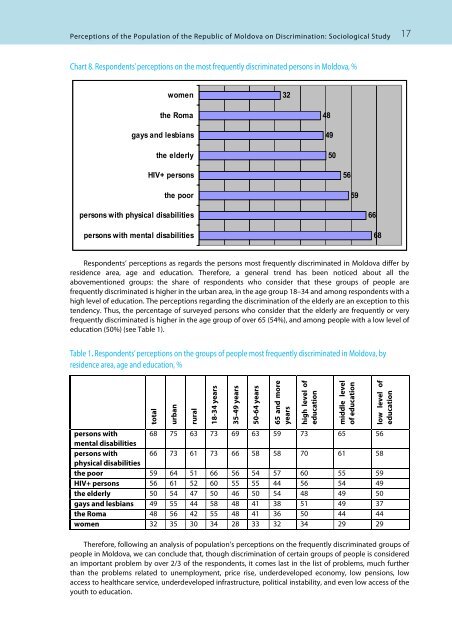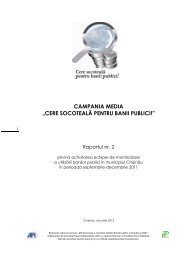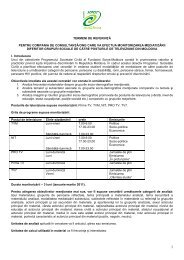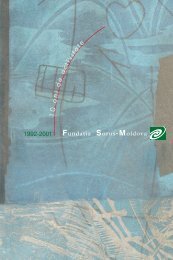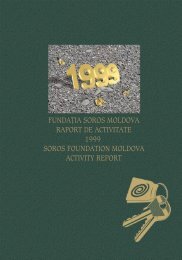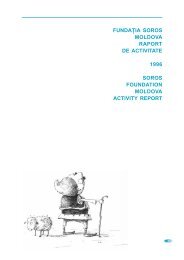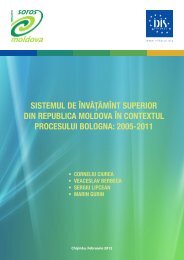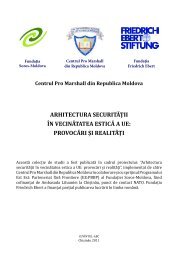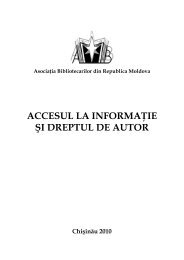Perceptions of the Population of the Republic of Moldova - Soros ...
Perceptions of the Population of the Republic of Moldova - Soros ...
Perceptions of the Population of the Republic of Moldova - Soros ...
- No tags were found...
Create successful ePaper yourself
Turn your PDF publications into a flip-book with our unique Google optimized e-Paper software.
<strong>Perceptions</strong> <strong>of</strong> <strong>the</strong> <strong>Population</strong> <strong>of</strong> <strong>the</strong> <strong>Republic</strong> <strong>of</strong> <strong>Moldova</strong> on Discrimination: Sociological Study 17Chart 8. Respondents’ perceptions on <strong>the</strong> most frequently discriminated persons in <strong>Moldova</strong>, %women32<strong>the</strong> Romagays and lesbians<strong>the</strong> elderly484950HIV+ persons<strong>the</strong> poor5659persons with physical disabilitiespersons with mental disabilities6668Respondents’ perceptions as regards <strong>the</strong> persons most frequently discriminated in <strong>Moldova</strong> differ byresidence area, age and education. Therefore, a general trend has been noticed about all <strong>the</strong>abovementioned groups: <strong>the</strong> share <strong>of</strong> respondents who consider that <strong>the</strong>se groups <strong>of</strong> people arefrequently discriminated is higher in <strong>the</strong> urban area, in <strong>the</strong> age group 18–34 and among respondents with ahigh level <strong>of</strong> education. The perceptions regarding <strong>the</strong> discrimination <strong>of</strong> <strong>the</strong> elderly are an exception to thistendency. Thus, <strong>the</strong> percentage <strong>of</strong> surveyed persons who consider that <strong>the</strong> elderly are frequently or veryfrequently discriminated is higher in <strong>the</strong> age group <strong>of</strong> over 65 (54%), and among people with a low level <strong>of</strong>education (50%) (see Table 1).Table 1. Respondents’ perceptions on <strong>the</strong> groups <strong>of</strong> people most frequently discriminated in <strong>Moldova</strong>, byresidence area, age and education, %totalurbanrural18-34 years35-49 years50-64 years65 and moreyearshigh level <strong>of</strong>educationmiddle level<strong>of</strong> educationlow level <strong>of</strong>educationpersons with 68 75 63 73 69 63 59 73 65 56mental disabilitiespersons with 66 73 61 73 66 58 58 70 61 58physical disabilities<strong>the</strong> poor 59 64 51 66 56 54 57 60 55 59HIV+ persons 56 61 52 60 55 55 44 56 54 49<strong>the</strong> elderly 50 54 47 50 46 50 54 48 49 50gays and lesbians 49 55 44 58 48 41 38 51 49 37<strong>the</strong> Roma 48 56 42 55 48 41 36 50 44 44women 32 35 30 34 28 33 32 34 29 29Therefore, following an analysis <strong>of</strong> population’s perceptions on <strong>the</strong> frequently discriminated groups <strong>of</strong>people in <strong>Moldova</strong>, we can conclude that, though discrimination <strong>of</strong> certain groups <strong>of</strong> people is consideredan important problem by over 2/3 <strong>of</strong> <strong>the</strong> respondents, it comes last in <strong>the</strong> list <strong>of</strong> problems, much fur<strong>the</strong>rthan <strong>the</strong> problems related to unemployment, price rise, underdeveloped economy, low pensions, lowaccess to healthcare service, underdeveloped infrastructure, political instability, and even low access <strong>of</strong> <strong>the</strong>youth to education.


